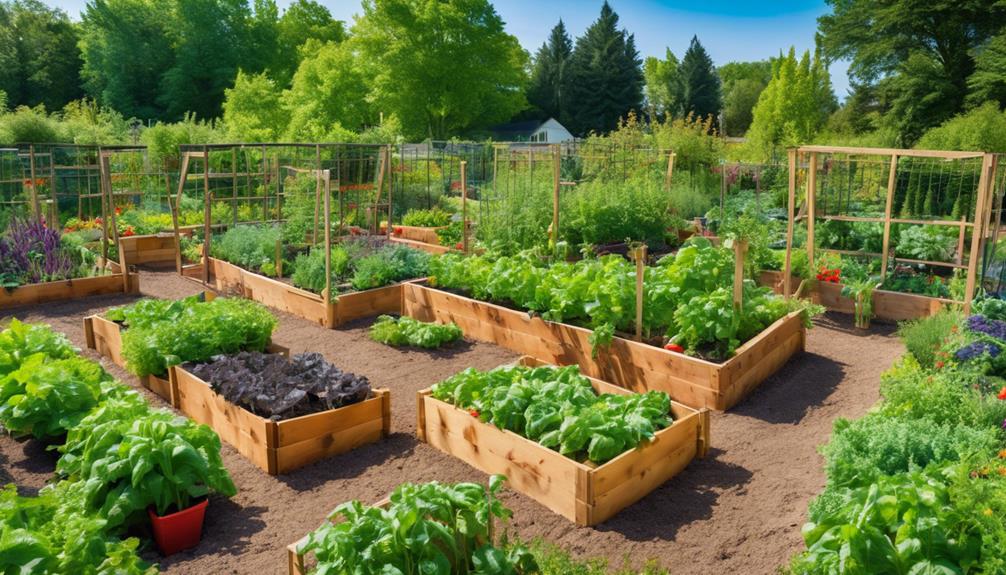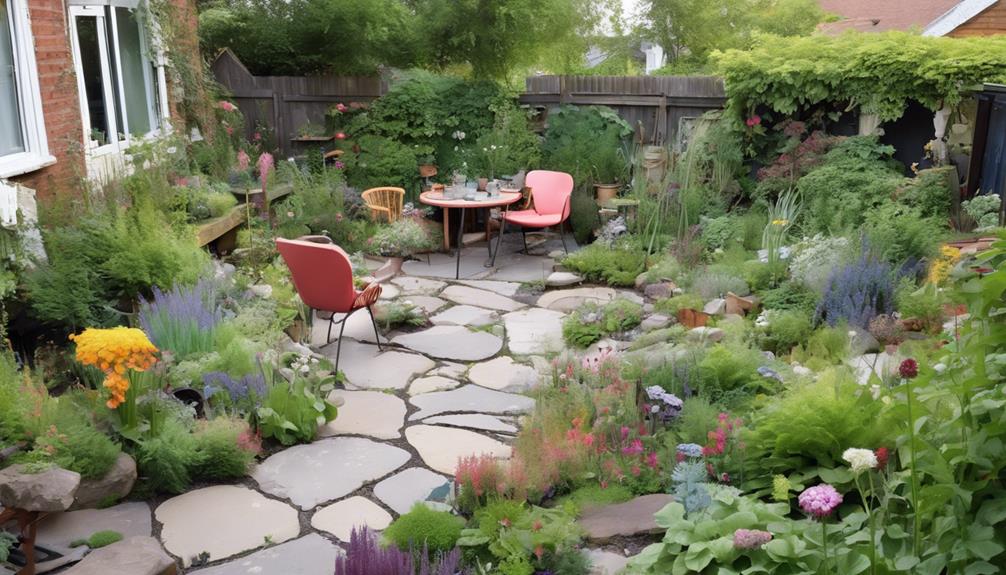
What Are Modern Hardscaping Styles for Gardens?
8 February 2025
Summer Garden Maintenance Quinton
8 February 2025Creating your perfect vegetable garden layout begins with a thoughtful design that optimises space and sunlight. Identify areas receiving at least six hours of direct sun, positioning taller plants strategically to avoid shading shorter crops.
Consider plant compatibility by selecting varieties with similar soil pH and sunlight requirements, which boosts growth and yields. Implement crop rotation and companion planting to improve soil health and deter pests.
Consistent watering and effective pest management are crucial for a thriving garden. Investigate methodologies and strategies to refine your approach, ensuring peak productivity and harmony in your garden design.
Garden Design Essentials
Effective garden design hinges on two critical factors: space and sunlight considerations, along with companion planting techniques.
Understanding the specific light requirements and spatial needs of diverse plants can greatly enhance growth and yield.
Furthermore, implementing companion planting strategies can optimise plant relationships, promoting healthier and more productive gardens.
Space and Sunlight Considerations
Creating a thriving vegetable garden begins with careful attention to space and sunlight considerations. The ideal garden layout requires an understanding of each plant's spatial needs, as overcrowding can stifle growth and lead to disease.
Allocate sufficient room for each vegetable, considering their mature size and potential spread. In addition, sunlight is essential; most vegetables require at least six hours of direct sunlight daily.
Observe your garden area throughout the day to identify sunlit zones and shaded spots created by trees or structures. Position taller plants strategically to minimise shading on shorter companions.
Companion Planting Techniques
Companion planting is a strategic approach that improves the growth and health of vegetables by pairing compatible species in close proximity. This technique utilises the natural relationships between plants to boost nutrient uptake, deter pests, and promote pollination.
For instance, planting basil alongside tomatoes not only enhances flavour but also repels harmful insects such as aphids. In the same way, the nitrogen-fixing capabilities of legumes benefit neighbouring crops like maize or cucumbers.
Furthermore, intercropping—the practice of growing different crops in proximity—optimises space and reduces weed competition.
Mastering these techniques requires an understanding of plant families and their specific needs, enabling gardeners to create a harmonious ecosystem that fosters biodiversity and resilience in the vegetable garden.
Plant Compatibility Considerations
Understanding plant compatibility is essential for a successful vegetable garden, as diverse species have differing sunlight exposure requirements and soil pH preferences.
Implementing effective companion planting strategies can enhance growth, deter pests, and improve overall yield.
Careful consideration of these factors will lead to a more harmonious and productive garden environment.
Sunlight Exposure Requirements
Sunlight exposure is a crucial factor in the successful layout of a vegetable garden, as it directly influences plant growth, yield, and overall health.
Understanding the sunlight requirements of different plants allows for strategic placement, maximising their potential. Here are key considerations for effective sunlight management:
- Full Sun (6-8 hours): Ideal for tomatoes, peppers, and courgettes, promoting robust growth and high yields.
- Partial Sun (4-6 hours): Suited for leafy greens such as spinach and lettuce, which thrive with some shade.
- Shade Tolerance: Root vegetables like carrots and beetroot can withstand lower light levels, allowing for diverse plantings.
- Plant Height: Taller plants should be positioned to the north or east, minimising shade cast on shorter crops.
Implementing these strategies guarantees a highly productive vegetable garden.
Soil Ph Levels
The health and productivity of a vegetable garden not only depend on sunlight exposure but also on the pH levels of the soil, which significantly affect plant compatibility and nutrient availability.
Understanding the ideal pH range for various vegetables is crucial for achieving a flourishing garden. Here are key considerations regarding soil pH:
- Ideal pH Range: Most vegetables prefer a pH between 6.0 and 7.5 for optimal nutrient uptake.
- Soil Testing: Regularly test soil pH using a reliable kit to ensure it falls within the desired range.
- Amendments: Use lime to raise pH levels or sulphur to lower them, depending on your soil's initial conditions.
- Plant Selection: Choose plants with compatible pH preferences to promote growth and yield.
Companion Planting Strategies
Companion planting strategies can significantly enhance the health and productivity of a vegetable garden by fostering beneficial relationships among plants.
Understanding plant compatibility is essential for optimising growth and pest resistance. Here are key considerations for effective companion planting:
- Nutrient Sharing: Some plants, such as legumes, fix nitrogen in the soil, benefiting neighbouring crops such as sweetcorn or peppers.
- Pest Repellent: Certain herbs, like basil, can deter pests when planted near vulnerable vegetables like tomatoes.
- Attracting Pollinators: Incorporating flowers such as marigolds can attract beneficial insects, enhancing pollination for nearby crops.
- Space Efficiency: Taller plants, like sunflowers, provide shade for shade-loving varieties, maximising garden space.
Implementing these strategies will lead to a more sustainable and productive vegetable garden.
Plan Your Garden Layout
Planning your garden layout is crucial for maximising productivity and ensuring healthy plant growth.
Begin by selecting an ideal location that receives adequate sunlight and has good soil drainage.
Furthermore, consider implementing crop rotation techniques and vertical gardening strategies to enhance space efficiency and reduce pest problems.
Select Your Garden Location
Choosing the right garden location is a critical step that can greatly influence the success of your vegetable garden. A well-situated garden optimises sunlight exposure, soil health, and accessibility.
To select the ideal location, consider the following factors:
- Sunlight: Ensure your garden receives at least 6-8 hours of direct sunlight daily, as most vegetables thrive in full sun.
- Drainage: Choose a site with good drainage to prevent waterlogging, which can lead to root rot and other diseases.
- Accessibility: Position your garden near your home for easy access to maintenance and harvesting.
- Wind Protection: Identify natural windbreaks to protect delicate plants from strong gusts, which can cause damage and stress.
Crop Rotation Techniques
To enhance soil fertility and reduce pest and disease accumulation, implementing effective crop rotation techniques is essential in your vegetable garden layout.
Crop rotation increases nutrient availability, minimises soil compaction, and disrupts pest life cycles. Here are four significant techniques to consider:
- Follow the Family: Rotate crops within the same plant family to prevent nutrient depletion and reduce disease susceptibility.
- Legume Inclusion: Incorporate legumes into your rotation to naturally fix nitrogen in the soil, thereby improving fertility for subsequent crops.
- Seasonal Planning: Plan rotations based on seasonal growth patterns, alternating between cool and warm-season crops.
- Soil Type Assessment: Tailor rotations to the specific soil type and conditions of your garden to optimise growth and health.
Mastering these techniques will enhance your gardening success.
Vertical Gardening Strategies
Vertical gardening offers a groundbreaking solution for optimising space and enhancing the aesthetic appeal of your vegetable garden layout.
By utilising vertical space, you can cultivate more plants in a limited area, creating an efficient and visually striking garden.
Consider the following strategies to master vertical gardening:
- Trellises: Implement sturdy trellises to support climbing plants such as beans and cucumbers, allowing for ideal sunlight exposure.
- Vertical Planters: Use wall-mounted or stacked planters to grow herbs and leafy greens, effectively utilising vertical height.
- Hanging Baskets: Incorporate hanging baskets for strawberries or cherry tomatoes, creating an eye-catching display that also saves ground space.
- Garden Towers: Invest in garden towers to optimise yield in smaller spaces, facilitating efficient watering and maintenance.
Embrace these strategies to enhance your gardening prowess.
Increased Crop Yields
Maximising crop yields in a vegetable garden requires careful planning and strategic layout design. A well-structured garden not only optimises space but also enhances sunlight exposure, water distribution, and nutrient availability. Implementing companion planting and crop rotation can further increase productivity.
| Plant Type | Companion Plants | Growth Benefits |
|---|---|---|
| Tomatoes | Basil, Marigold | Improved flavour, pest resistance |
| Carrots | Onions, Lettuce | Reduced pest harm, space efficiency |
| Peppers | Aubergine, Garlic | Improved growth, disease prevention |
Pest Management Techniques
Effective pest management is crucial for maintaining a healthy vegetable garden.
Employing organic pest control methods, introducing beneficial insects, and applying neem oil are key strategies that can significantly reduce pest populations while preserving the ecosystem.
Organic Pest Control Methods
In the realm of sustainable gardening, organic pest control methods serve as essential strategies for maintaining plant health while minimising environmental impact.
These techniques empower gardeners to manage pests effectively without resorting to synthetic chemicals. Here are four fundamental organic pest control methods:
- Crop Rotation: Alternating plant families each season disrupts pest life cycles and reduces infestations.
- Natural Barriers: Employing row covers or netting can physically protect plants from pests while allowing light and moisture to penetrate.
- Homemade Sprays: Utilising mixtures such as neem oil or soapy water can deter common pests without harming beneficial organisms.
- Companion Planting: Strategically interplanting species can repel pests or attract beneficial insects, enhancing overall garden resilience.
Implementing these methods fosters an ecological balance in your vegetable garden.
Beneficial Insect Introductions
Building on the foundation of organic pest control methods, the introduction of beneficial insects presents a powerful strategy for managing pests in vegetable gardens.
By carefully selecting and introducing these allies, gardeners can improve biodiversity and promote a balanced ecosystem.
Here are four key beneficial insects to consider:
- Ladybirds – Effective against aphids and other soft-bodied pests.
- Lacewings – Their larvae consume a variety of pests, including thrips and spider mites.
- Parasitic Wasps – These tiny wasps target pest larvae, such as caterpillars and aphids.
- Predatory Mites – Particularly useful in controlling spider mites and other mite species.
Integrating these beneficial insects into your garden can greatly reduce pest populations while minimising reliance on chemical interventions.
Neem Oil Treatment Application
Neem oil, derived from the seeds of the neem tree, serves as a versatile organic solution for pest management in vegetable gardens. This natural insecticide disrupts the life cycle of pests without harming beneficial insects when applied correctly.
To effectively utilise neem oil, follow these crucial steps:
- Dilution: Mix neem oil with water and a mild soap to improve emulsification and effectiveness.
- Timing: Apply during the early morning or late afternoon to avoid the heat of the sun, which can degrade the oil.
- Coverage: Ensure thorough application on both the tops and undersides of leaves, as pests often hide there.
- Frequency: Reapply every 7 to 14 days, especially after rain, to maintain pest control efficiency.
Master these techniques for optimal results.
Watering Consistency Issues
Consistent watering is vital for the health of any vegetable garden, and addressing potential issues in this area can significantly affect plant growth.
This discussion will cover important strategies, including the installation of an effective irrigation system, methods for enhancing soil moisture retention, and the benefits of mulching.
Irrigation System Installation Guide
Establishing a reliable irrigation system is crucial for maintaining the health and productivity of your vegetable garden.
A well-designed irrigation setup not only guarantees consistent watering but also conserves water and reduces labour.
Follow these steps to create an effective irrigation system:
- Assess Your Garden Layout: Evaluate the size and shape of your garden to determine the best irrigation method, whether drip, sprinklers, or soaker hoses.
- Plan Water Source Accessibility: Identify the nearest water source and plan the layout to minimise hose lengths and optimise pressure.
- Install Timers: Utilise irrigation timers to automate watering schedules, providing consistency regardless of weather conditions.
- Monitor and Adjust: Regularly check the system for clogs or leaks, and adjust watering amounts based on plant needs and seasonal changes.
Soil Moisture Retention Techniques
Effective soil moisture retention is essential for ensuring that vegetables thrive in your garden, particularly during periods of inconsistent rainfall or high temperatures.
Implementing robust techniques can greatly improve water retention in your soil, promoting healthier plant growth and reducing irrigation needs.
Consider the following strategies:
- Soil Amendments: Incorporate organic matter, such as compost or well-rotted manure, to improve soil structure and moisture-holding capacity.
- Deep Watering: Water deeply and less frequently to encourage deep root development, allowing plants to access moisture stored below the surface.
- Drought-Resistant Varieties: Select vegetable varieties that are bred for drought resistance, thereby reducing overall water consumption.
- Cover Crops: Planting cover crops during the off-season can improve soil health and moisture retention, adding organic matter when turned under.
Mulching for Moisture Retention
How can mulching significantly improve moisture retention in your vegetable garden?
Mulching serves as an essential technique to minimise evaporation and maintain consistent soil moisture levels. By forming a protective layer over the soil, it effectively reduces water loss while also suppressing weed growth that competes for moisture.
Consider these key benefits of mulching for moisture retention:
- Evaporation Reduction: Mulch limits direct exposure to sun and wind, considerably decreasing moisture loss.
- Soil Temperature Regulation: It helps maintain stable soil temperatures, fostering healthier root systems.
- Organic Matter Contribution: Organic mulches decompose over time, enriching the soil with nutrients that enhance moisture-holding capacity.
- Weed Suppression: A thick layer of mulch inhibits weed growth, ensuring that moisture is directed to your plants rather than competing flora.
Why Choose TKL Birmingham Gardener
When considering the ideal partner for your vegetable garden layout, TKL Birmingham Gardener stands out due to its commitment to quality and expertise.
With a team of seasoned horticulturists, TKL Birmingham Gardener employs a holistic approach to garden design, ensuring that every element—from soil composition to plant selection—works in harmony to optimise yield.
Their emphasis on sustainable practices not only enhances the garden's productivity but also minimises environmental impact, catering to the discerning gardener's desire for ecological responsibility.
In addition, TKL offers personalised consultations, allowing for tailored solutions that meet specific gardening aspirations.
Common Gardening Questions Answered
In the realm of vegetable gardening, many enthusiasts often find themselves grappling with a multitude of questions that can impact their gardening success.
Common enquiries include the ideal spacing for different plants, which directly affects air circulation and nutrient accessibility.
Another frequent concern revolves around soil quality; understanding the importance of pH levels and organic matter can greatly enhance plant growth.
Moreover, gardeners often seek guidance on pest management strategies, emphasising the need for integrated pest management to minimise chemical use.
Proper watering techniques are also crucial, as both overwatering and underwatering can be detrimental.
Future Planting Schedule Tips
Planning a future planting schedule is crucial for maximising the productivity of a vegetable garden. A well-structured schedule allows gardeners to refine crop rotation, manage seasonal growth, and ensure a continuous harvest.
Here are four key tips for developing an effective planting schedule:
- Understand Planting Zones: Research your hardiness zone to determine the ideal planting times for different vegetables.
- Rotate Crops: Implement a rotation plan to prevent nutrient depletion and control pests.
- Succession Planting: Stagger plantings of similar crops to prolong harvest periods and reduce waste.
- Utilise Companion Planting: Pair plants that enhance each other's growth and deter pests, maximising garden efficiency.




